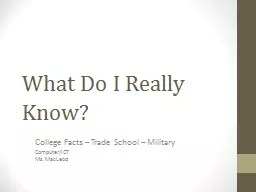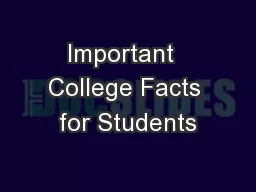PPT-What Do I Really Know? College Facts – Trade School – Military
Author : calandra-battersby | Published Date : 2019-03-02
ComputerICT Ms MacLeod I nformation C ategories About Colleges Location The geographic region where the campus is located within the state of California Setting
Presentation Embed Code
Download Presentation
Download Presentation The PPT/PDF document "What Do I Really Know? College Facts –..." is the property of its rightful owner. Permission is granted to download and print the materials on this website for personal, non-commercial use only, and to display it on your personal computer provided you do not modify the materials and that you retain all copyright notices contained in the materials. By downloading content from our website, you accept the terms of this agreement.
What Do I Really Know? College Facts – Trade School – Military: Transcript
Download Rules Of Document
"What Do I Really Know? College Facts – Trade School – Military"The content belongs to its owner. You may download and print it for personal use, without modification, and keep all copyright notices. By downloading, you agree to these terms.
Related Documents














